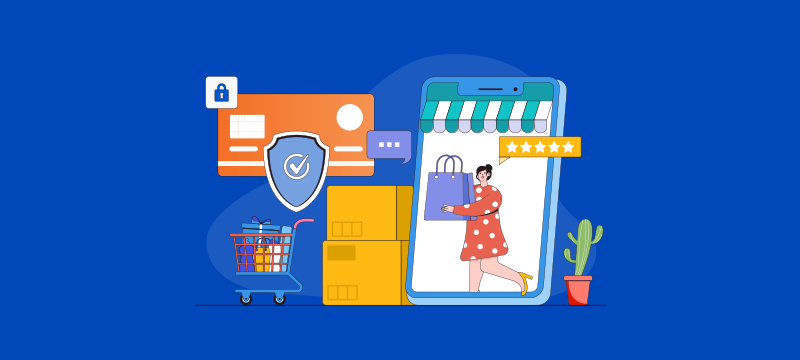Are you confident that your eCommerce store is protected against cyber threats? If not, what are your biggest security concerns? You are certainly on the right place. Here, in this blog, we will explore essential security requirements and best practices to safeguard e-commerce websites from cyber threats, ensuring customer trust and business continuity.
The rapid growth of eCommerce has made online shopping more suitable, but it has also attracted cybercriminals looking to exploit vulnerabilities in online stores. A single security breach can compromise sensitive customer data, leading to financial loss, legal penalties, and reputational damage. Ensuring strong security measures for an eCommerce website is not just an option; it is a necessity.
Essential Security Requirements for eCommerce Websites
- SSL Certificate & HTTPS Encryption The first and foremost step to secure an eCommerce website is implementing an SSL (Secure Sockets Layer) certificate. It encrypts communication between the user’s browser and the website, preventing data interception. HTTP (Hypertext Transfer Protocol Secure) is now a standard for secure transactions, boosting trust and improving SEO rankings.
- Secure Payment Gateway Handling financial transactions requires compliance with PCI-DSS (Payment Card Industry Data Security Standard) regulations. This ensures that sensitive payment information, such as credit card details, is processed securely. Using trusted payment gateways like PayPal, Stripe, or Authorize.net can protect both customers and businesses from fraud.
- Strong Authentication Mechanisms To prevent unauthorized access, strong authentication mechanisms should be in place. This includes:
- Two-factor authentication (2FA) for admins and customers.
- Strong password policies require a mix of uppercase and lowercase letters, numbers, and special characters.
- Automatic account lockouts after multiple failed login attempts.
- Regular Security Audits & Updates Cyber threats evolve constantly, making regular security audits crucial. Keeping CMS platforms, plugins, themes, and scripts updated helps fix vulnerabilities before they are exploited by hackers. Automated patch management can ensure seamless updates.
- Robust Web Application Firewall (WAF) A Web Application Firewall (WAF) protects an e-commerce site from SQL injections, cross-site scripting (XSS) attacks, and other malicious activities. It filters incoming traffic, blocking suspicious requests before they reach the website.
9 Best Practices for eCommerce Security
- Use Secure Hosting & Regular Backups Selecting a reliable and affordable web hosting provider with built-in security features is a must. Managed hosting solutions offer firewalls, malware scanning, and automated backups, guaranteeing business continuity in case of cyberattacks. Offsite backups should be stored for disaster recovery.
- Monitor & Limit User Access It is not necessary for everyone should have access to important files and databases. Some of the best practices include:
- Assigning role-based access controls (RBAC) to limit user permissions.
- Using unique admin credentials instead of common usernames like “admin.”
- Employ Multi-Layered Security Measures A single security solution is not enough. Executing multiple security layers can significantly lessen risks:
- CAPTCHA and bot detection to stop automated attacks.
- Security plugins and tools like Wordfence, Sucuri, and Cloudflare for real-time monitoring.
- Encrypt & Protect Customer Data Data breaches often target stored customer information. To prevent exposure:
- Store passwords using hashing and salting techniques.
- Encrypt sensitive data both in transit and at rest.
- Use tokenization for payment details, replacing card information with unique tokens.
- Educate Employees & Customers Employees are often the first line of defense against cyber threats. Training them on security best practices can avoid common attacks like phishing. Customers should also be encouraged to:
- Use strong passwords.
- Avoid sharing login credentials via email.
- Implement Fraud Detection Mechanisms eCommerce websites are often targeted for fraudulent transactions. Hence, fraud detection systems should be implemented such as:
- Monitor transactions for suspicious activities.
- Use AI-based fraud detection tools to identify unusual purchase patterns.
- Implement geolocation tracking to stop unlawful transactions from unknown locations.
- Secure APIs & Third-Party Integrations Many e-commerce websites depend on APIs for payment processing, inventory management, and customer support. Securing APIs includes:
- Using OAuth authentication to prevent unauthorized access.
- Enforcing API rate limiting to block excessive requests.
- DDoS Protection & Traffic Monitoring Distributed Denial of Service (DDoS) attacks can take an e-commerce website offline. To stop this:
- Use DDoS mitigation tools such as Cloudflare, Akamai, or AWS Shield.
- Legal & Compliance Measures Compliance with security guidelines helps build trust and avoid legal consequences. Some important regulations include:
- GDPR (General Data Protection Regulation) for handling customer data in the EU.
- CCPA (California Consumer Privacy Act) for businesses operating in California.
- PCI-DSS compliance for processing credit card payments securely.
Conclusion:
Ensuring the security of your eCommerce website isn’t just a one-time task—it’s an ongoing assurance. From SSL encryption to access controls and multi-layered security solutions, every measure strengthens your platform against cyber threats. Selecting a cheap Linux VPS offered by bodhost with strong security features can further improve protection while keeping costs low. A secure website not only protects sensitive customer data but also builds trust and credibility, keeping your business running smoothly.
By prioritizing security today, you safeguard your brand’s reputation, prevent costly breaches, and create a seamless shopping experience for your customers. In the ever-evolving digital landscape, staying proactive is the key to long-term success.
Learn more: What types of data should eCommerce sites protect?
